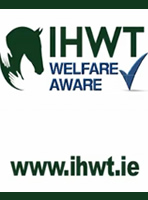
Horseytalk.net Special Interview
Sara Longworth
How to Ensure You Are Prepared for Your First Foal
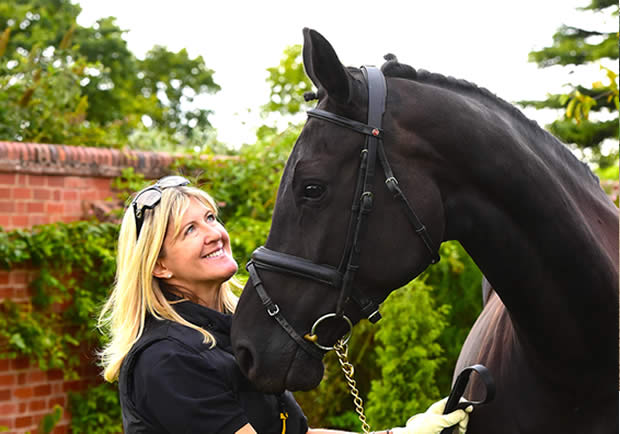
Says Sara Longworth of Waverley Stud, Warwickshire
The birth of your first foal is undoubtedly one of the most exiting experiences for any horse owner, but this excitement can also be mixed with anxiety about what to expect and the outside chance that something could go wrong.
As the owner of Waverley Stud I have seen many generations of foals born but I still find every new safe arrival a magical experience. Foaling is a natural process and most mares instinctively know what to do, but knowing that I am well prepared, with essential foaling supplies restocked, is key to my peace of mind.
One month before foaling (we use an average gestation period of 342 days from the last date of covering for our calculations) our mares have a flu and tetanus vaccination. This allows some immunity to be passed to the foals, giving them protection for the first few months of life.
At least three weeks before the due date we also make an appointment with our vet to unstitch any mares that have had a Caslick procedure – this is essential to prevent the mare from tearing and allow easy exit of the foal. (If you aren't sure if your mare has a Caslick, then ask your vet to examine her at least three weeks before her due date so that appropriate action can be taken.) If you want to use an internal foal alarm (which we do not), it could be inserted by your vet at the same time.
Two or three days before the due date (or before, if it looks as though delivery will be early) we worm our mares to help prevent any eggs in the mare's system from passing to the foal through her milk. (Always check the literature that comes with the wormer to establish that it is safe for use with pregnant mares.)
By this time you will also have decided where you are going to foal your mare and where it will be turned out post foaling. We always foal our mares in the stable, but if you decide to foal your mare outside it should be in a small paddock (so that the mare cannot take herself too far away – she will normally go to the most remote and quiet part of the field) and where there is a reliable means of artificial light in case of an emergency, as things can and do go wrong – and most foals are born after dark when it is quiet and peaceful.
Any paddock should be free of obstacles and have secure fencing: post and rail is best, with the bottom rail close enough to the ground to prevent a foal rolling under it and, inadvertently, getting separated from its mother. And of course these safeguards hold true for the field you intend to use for your mare and foal after the birth.
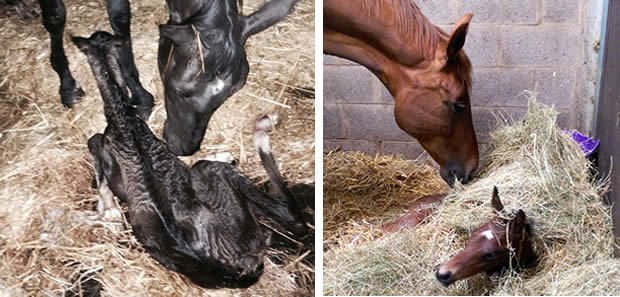
At Waverley Stud we have a number of large foaling boxes with CCTV cameras, electric light and fixed rubber floors (these are more hygienic than mats as no fluids can get underneath them and they help to cushion the inevitable tumbles of a newborn foal). The stables are thoroughly disinfected before each use. A foaling box must be larger in size than a standard stable and preferably square in shape to allow plenty of room around the mare when she goes down to foal. It should be free of sharp or projecting objects. We use a thick layer of straw as it helps to absorb birthing fluids, provides a soft landing for wobbly foals, and is non hazardous if the foal tries to eat it – it is amazing how many foals will try to eat the surface they are lying on within an hour or so of being born! However some experts advocate only the minimum of bedding, arguing that it helps the foal get to its feet sooner and aids balance once it is up.
We set up our foaling kit in a big white Perspex container at the beginning of the season with items that will be required immediately after birth, and some that could be needed in case of emergency.
It contains:
- phone numbers for our vet on the lid of the box (all of us have the number in our mobile phones too)
- a plentiful supply of sterile gloves for washing the mare and handling the placenta
- scissors for cutting umbilical tape or tail wrap; or more seriously, in case of an emergency, for dealing with a red bag birth (where the placenta would need to be cut open), or, again in rare cases, for the need to cut the umbilical cord
- canister of oxygen with nose cone, in case of red bag birth (we are also thinking of buying a full resuscitation device just in case a foal has difficulty breathing after birth)
- umbilical tape or clamp, in case the umbilical cord needs tying off immediately after foaling
- ·antiseptic spray to disinfect the umbilical stump and reduce possibility of bacterial infection
- towels, to dry off and stimulate breathing in the new born foal
- thermometer – for mare and new born foal
- whole foal colostrum in case the mare doesn't have any or does not produce enough
- foal milk replacer in case the worst happens and the mare is lost
- plastic bottle and rubber teat for feeding a foal
- large container for milking the mare (in case the foal takes a long time to stand and suckle)
- anti-septic spray for the umbilical cord
- enema (sodium phosphate type) to administer to a new born foal in case of meconium impaction
- If you don't have good artificial light in the stable and in the yard, you will also need a strong torch or head light
In a covered bucket, alongside the foaling kit, we also keep mild liquid soap for washing the udder and genital area of the mare prior to foaling, and an extra long tail bandage to keep the mare's tail hair out of the way throughout proceedings. A head collar and lead rope always hang outside the stable door.
Most of our mares tell us when foaling is imminent, with some habitually foaling before or after their due dates. Maiden mares are often late. A few days before, or even on the day itself, the udder swells ('bags up') and beads of colostrum begin to appear on the teat.
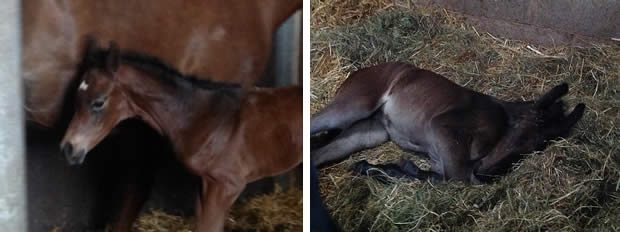
The bulk of the foal moves backwards visibly towards the mare's pelvis – this is particularly clear when viewed from above through the CCTV. Time to set up watch in front of the CCTV! If you don't have CCTV you will have to keep checking. Before we had CCTV we used to rig up a camp bed in the box next door!
Most, but not all, mares will exhibit disturbed behaviour immediately prior to foaling. They can walk the box, paw at the bedding, lie down and get up again. It is better not to interfere with your mare during delivery unless there is a problem.
In my experience foaling usually occurs within 30 minutes of the waters breaking. Then the mare will lie on her side and stay down. Minutes later the foal's feet appear, followed quickly by the nose and head. The shoulders can take a little longer to emerge, but from the moment the mare goes down and lies on her side, it is normal for the birthing process to take no more than fifteen minutes from beginning to end: and it is often much quicker than that!
The mare and foal may then rest for a while following the birth before the bonding process begins.
While this is happening I collect up and examine the afterbirth or placenta, laying it out on the concrete which is then scrubbed with Vircon. It should be complete and look like a baggy pair of trousers, with one 'leg' (the horn where the foetus grew) much bigger than the other. You should be able to identify the hole that the foal made during its birth. Even now, if I'm worried that I haven't quite got a whole placenta, I ask my vet to check it. I then put it in a black plastic bag in a bucket where marauding wild life cannot reach it, ready for burning.
The foal should start trying to get to its feet within about 30 minutes of birth – though again some are much quicker - and should be suckling within an hour to an hour and a half. There is nothing better than that noisy gurgling sucking sound as a reward for all your efforts! If it looks like it will take longer than this I tend to milk the mare and feed the colostrum to the foal in a bottle to ensure that it has the energy and health giving benefits of the mare's colostrum beginning to go to work inside it.
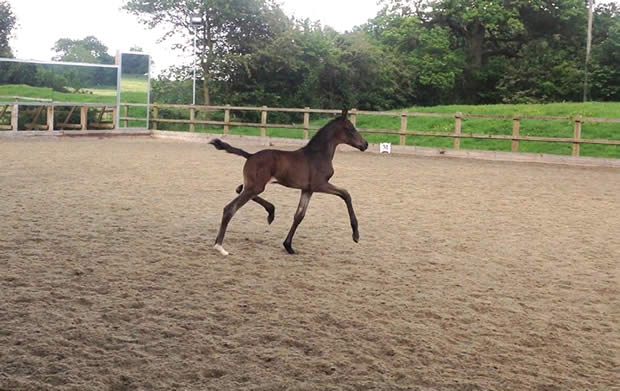
I do not use rugs after the birth for either mare or foal, even if it is cold, for fear of endangering a foal's attempts to stand and its vital need to suckle. A good covering of straw over a recumbent foal, once it is dry, will keep it warm enough. My mares get a hot bran mash, with lots of molasses, after they have foaled. I think this is comforting for them, but also helps combat the tendency to colic that often accompanies foaling.
Once all this is done, and I'm confident the foal can get to its feet and find milk without my help, I go to bed for a few hours. I then wake up 3 hours later and watch the CCTV to ensure the foal is suckling well.
Finally, within 12 and 24 hours of birth, foals should have their blood tested to determine if they have received adequate passive transfer of antibodies from the mare's colostrum. If the results are inadequate or even borderline the foal may need a plasma transfusion – this requirement is not unusual, and is especially common with older mares who may begin to run milk well before the birth, so losing all their colostrum.
A healthy foal that has had a stress free birth will benefit from getting out in the paddock as soon as possible; this could be within the first 24 hours of birth. One of our mares however refuses to leave the stable for about 48 hours after a birth and she tells us when she's ready to go out!
 If this is your first experience of foaling, make good use of the months leading up to the birth, to educate yourself on the birth process as much as possible. This knowledge could prove vital in recognising the early signs of something going wrong. It is also strongly recommended that you meet with your vet to determine what equipment and help is right for your foaling situation, to make sure you know when and how to use the equipment you have and to establish what signs or eventualities should trigger a call for emergency help.
If this is your first experience of foaling, make good use of the months leading up to the birth, to educate yourself on the birth process as much as possible. This knowledge could prove vital in recognising the early signs of something going wrong. It is also strongly recommended that you meet with your vet to determine what equipment and help is right for your foaling situation, to make sure you know when and how to use the equipment you have and to establish what signs or eventualities should trigger a call for emergency help.
Most mares cope well with foaling without any help but it is always wise to be prepared, and in the excitement of live foaling, the organising and homework you do now will payoff handsomely. After all this is the moment you have been waiting and planning for, for some months, maybe years!
To find out more about Waverley Stud, and their exceptional youngstock visit www.waverleystud.com
or call Sara Longworth on (07770) 999755.





